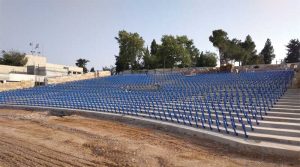by Hadar Halperin, Julie Holmquist, Haggai Shoshany, and Jessi Meyer, FICRI

When building infrastructure, there is often little, if any, ability to control the environment in which the roads, bridges, drainage culverts, or other public structures are built. Infrastructure must be made to fit the environment, which already exists to support a healthily functioning society. This leaves contractors and engineers with the job of constructing buildings that will last for many decades, in spite of exposure to harsh climate, soil, and water conditions.
Engineering consultant companies in Israel are finding many advantages in following a ‘performance-based design’ approach incorporating migrating corrosion inhibitor technology. This article follows three public works projects on which the performance-based design approach was applied. Each project presented the especially difficult challenge of casting thick pieces of concrete in harsh environmental conditions while seeking to achieve a 100-year service life. Although designed to comply with specifications specific to Europe and Israel, these projects provide an insight into strategies for building infrastructure with greater durability in harsh conditions anywhere in the world.
Performance versus prescriptive specifications
Around the turn of the millennium, the construction industry began realizing buildings were not meeting their planned service life, and therefore introduced the concept of durability in environmental conditions in industry standards. Until then, civil and infrastructure engineers mainly referred to mechanical considerations (tensile and compressive strength, etc.). In Europe, these considerations are reflected within the EN 206-1, Concrete – Specification, Performance, Production and Conformity, Part 1 (see EN 206-1:2000, Concrete – Specification, Performance, Production and Conformity, Part 1, British Standards Institution, London, United Kingdom). The Israeli equivalent is IS 118, Concrete: Specification, Performance and Production (consult IS 118:2008, Concrete: Specification, Performance and Production, Standards Institution of Israel, Tel Aviv, Israel). These standards encompass both a ‘prescriptive approach’ and a ‘performance approach.’ The American Concrete Institute (ACI) 318-08, Building Code Requirements for Structural Concrete and Commentary, and ACI 301-05, Specifications for Structural Concrete, are examples of specifications encompassing prescriptive and performance-based requirements in the United States. While both types of specifications have existed in the United States since the first half of the 20th century, there has also been an increasing realization over the last several decades about the importance of building for durability using a performance-related approach.

Photos courtesy Glimmer Industrial Consultation
Engineers have both a professional and legal obligation to meet standards like these in order to guarantee the quality, safety, and longevity of the construction project. It is the engineer’s responsibility to stay updated on current standards and plan accordingly. In Europe and Israel, for example, EN 206-1 and IS 118 standards define several categories of environmental conditions to help engineers plan for durability such as:
- soil composition chemical aggressiveness;
- air with high concentration of chlorides;
- air with high concentration of carbon dioxide (CO2); and
- the frequent freeze-thaw cycles (freeze-thaw is included in EN 206-1 but is omitted from IS 118 because cold weather almost never occurs in Israel).
The standards give each category a letter code with a range of numbers describing the severity of conditions. After these conditions are identified, both the European and Israeli standards give the construction engineer two options to ensure durability in these circumstances (section 5.3.1 in both standards).
Option 1: Limiting values/prescriptive approach
This approach is intended to improve concrete coverage over rebar, thus delaying ingress of harsh elements through the concrete and extending the corrosion incubation period. After rebar corrosion initiates, corrosion propagation begins—the steel inflates, causing concrete cracking, delamination, and further exposure to corrosion agents and bringing service life to an end.
Option 2: Performance-related design approach
This approach is intended to improve rebar durability and resistance to corrosion, thus raising the chemical concentration threshold at which corrosion initiates (extending the corrosion incubation period), and slowing down the corrosion rate (extending the period of corrosion propagation until cracking begins). This option has several advantages, such as:
- lets engineers reduce the quantity of cement in the mix as compared to the quantity of cement that is needed in the prescriptive approach, which helps minimize thermal and plastic cracking as less cement generates lower heat and results in reduced shrinkage of concrete after casting;
- allows for a shallower concrete coverage on the rebar;
- permits engineers to use smaller amounts of rebar; and
- continues to provide protection if application errors ever occur (no casting is perfect), while Option 1 fails.
A closer look at three specific project environments
Due to its advantages, the performance-based approach played an important role in designing three different infrastructure projects in Israel: an outdoor amphitheater, a stormwater drainage culvert, and a tunnel to capture floodwater. Each of these projects was to be constructed in moderately harsh to severe conditions, while planning for a 100-year service life. Each project opted to follow performance-based concrete design strategies that specified a migrating corrosion inhibitor or its equivalent.




